

Carsten Aniksdal in collaboration with Sebastian Rusten
Sebastian Rusten and Milton Mondal
In this text, Rusten looks at the ancient art of spruce root basket weaving to reflect upon his artistic practice, which relates and communicates with a non-human world through foraging and craft. A practice that is a continuing exploration of self in relation to a more-than-human world. In the text, Rusten draws on indigenous ways of being, Buddhist thought, the philosophy of Gilles Deleuze, and the anthropological research of David Abraham.
I’m in Alaska. I’m kneeling between several large spruce trees near Eagle Beach, a short drive north from the state capital of Juneau.
Our teacher Deborah Head (Aanutein, her Tlingit name), a basket weaver with both Tlingit and Haida ancestry, has brought a small group of students out here to dig for spruce roots that we are eventually going to process and use for basket weaving.1 We started our morning in a classroom, but Deborah waited until we made it out into the forest before she introduced herself in her native Tlingit. She also introduced us to A'aakw Kwáan, the name of the place, but also of the people who inhabited the Juneau area and parts of Admiralty Island for thousands of years before it became a mining settlement in the 1880s.
It was an overwhelming thing to be introduced to the land in this way. Having come such a distance to learn about the ancient art of spruce root basket weaving significantly amplified the feeling. The group scattered to find good spots for root harvesting. I was by myself when I found a promising area; I was surrounded by large spruce trees, the ground was soft and uniformly covered in moss, and there were no other bushes or plants to complicate the digging process. I kneeled down and sat for a while, quietly breathing in the moment. According to custom, I thanked A’aakw Kwáan for allowing me to be present, and asked for permission to start digging for roots. I felt the embrace of the land. I was absorbed. Maybe it is just a sensation that comes from acknowledging the gift of the moment; maybe A’aakw Kwáan was telling me that everything was just right, A’aakw Kwáan’s consciousness arising in my own. Most likely, these are just different facets of our entanglement.
I have rarely felt as close to the land as I did then. While I was in a strange and beautiful place, I do not think the location was the key to the experience. I think it had everything to do with how Deborah Head introduced us to the land and put us in the appropriate state of mind before harvesting. She conveyed the importance of proper harvest; always give thanks and ask the land for permission to dig, only dig within a 30-degree area of the circumference of a tree, take no more than 10-12 roots from each spot, move beyond adjacent trees when finding a second location, and when moving on, always replace soil and moss to make it look as untouched as possible. Along with this preparation we were also, in taking part in the class, tapped into a tradition that had been developed with the land and practised there for at least 5450 years, the dating of the oldest known spruce root basket. All these elements came together to make communication with the land possible.
I felt the embrace of the land. I was absorbed. Maybe it is just a sensation that comes from acknowledging the gift of the moment; maybe A’aakw Kwáan was telling me that everything was just right, A’aakw Kwáan’s consciousness arising in my own.
Continually pursuing an artistic practice that would allow me to engage with nature eventually developed into a practice based on relating and communicating with a non-human world through foraging and craft. It is a continuing exploration of self in relation to a more-than-human world. I observe how collaborating with materials can aid me in perceiving differently and create a sense of symbiosis with the materials I engage with. Working with traditional crafts like basketmaking, weaving, and woodwork allows me to connect to ancient knowledge, and lets me tap into ways of becoming with a more-than-human world.2 Building relationships with materials through craft creates a basis for this connection.
The way this practice has developed has also made it hard to separate life and art. My practice has become the lens through which I view and understand the world and how I can find a place in it. Practice seeps in everywhere, and life is re-evaluated accordingly. The way it has developed has also entangled it with an intensely spiritual journey. An important aspect of my life and work has therefore been to gradually re-engage with Buddhism in adulthood and eventually adopt a daily meditation practice. My foraging and artistic practice has become a spiritual practice – Buddhism is one cornerstone for exploring and understanding this, and engaging with traditional thought around foraging and craft is another. Taking this on means that, to me at least, the materials I work with also become loaded with spirit. Not a specific charge, but an added heaviness that affects me in relating to them.
In creating works, I have looked for ways that the materials can come together in temporary assemblages. I try to highlight materiality and the sensuousness inherent in the materials. Working this way also means that the artworks only last the length of the exhibition period. Ground spruce needles form surfaces that dry where it is placed and crumbles if moved. Powder images are not fixated and mix in with the yellowing spruce needles. Temporality is a limitation built into this mode of work, which also allows me to reuse materials and experience how they change when inevitably mixed. It also makes it harder to get caught up in a materialistic culture, and gives me more agency, potentially, in creating a role for myself where my practice interferes with the art world.
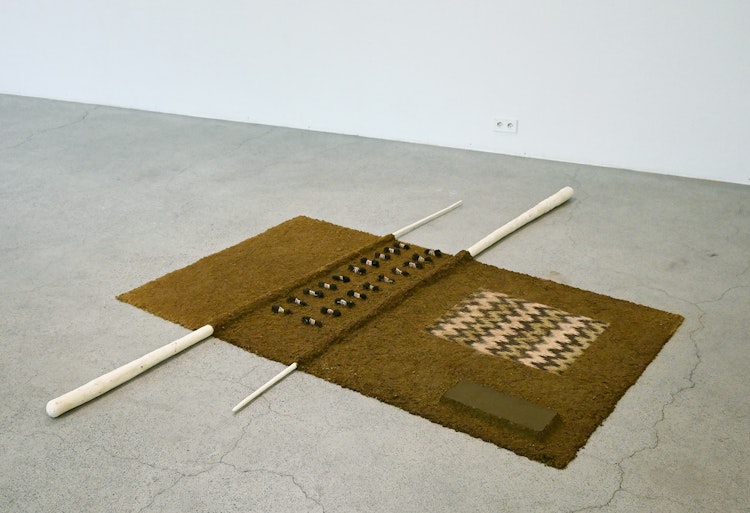
The recurring title that I use in my work is Heaps. These works refer to the Buddhist concept of the five skandhas; these are the five elements that sum up the whole of an individual´s mental and physical existence, which in English translates into “aggregates” or “heaps”.3 According to the second noble truth, suffering is said to arise from attachment.4 There are several forms of attachment; they are all said to stem from an attachment to the idea of a permanent self. The five skandhas provide a template for the elements that make up our notion of self. The idea of the skandhas can be used in meditation as a way of de-constructing the idea of self in search of an essence, what some might call a soul; something permanent that lives on after death. The intended result of the five skandhas meditation is that there is no essence to be found anywhere. We are assemblages of these different heaps of stuff, or processes which are always evolving and interacting with each other. Not only within ourselves, but also with other heaps outside our idea of self. So, there is nothing permanent in us, the only constant is change.
Heaps became a physical manifestation of this meditation for
me. Different aspects of a non-human world foraged, de-constructed and
re-assembled to expose its different parts and a lack of essence even in
an effort to extract material essences.
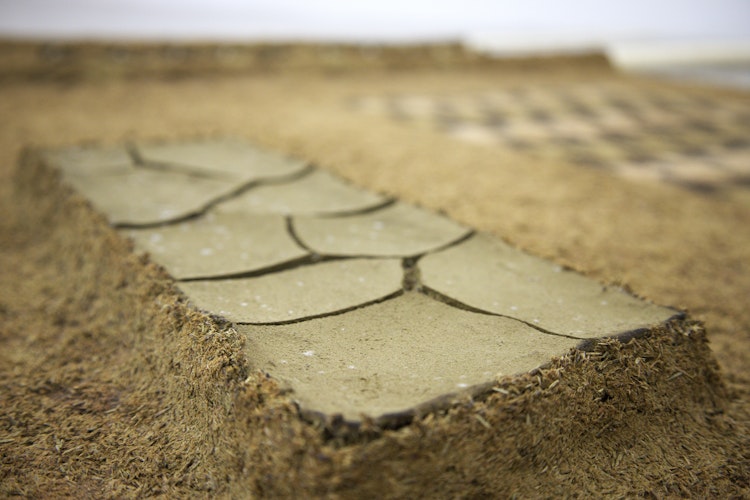
In the space where the self is not, there is emptiness; in fact, emptiness is all there is, it is a scary feature of Buddhism that is somewhat misconstrued. It is not a nihilistic void of nothingness, it is space, it is open.5 One of the reasons why the word “emptiness” is used is because it is much more difficult to attach oneself to emptiness than, for instance, a god. I have come to see the zigzag as a symbol for movement or a way of navigating this unknowable space, which is simultaneously everything and nothing, lurking between, behind, and in everything. It is a connecting movement back and forth between the material and the immaterial, active and passive, birth and death, fact and fiction, exposing apparent opposites as points on the same surface. It helps me inhabit this vague and hard-to-access place. The zigzag is the buzzing energy that fills me when I feel connected to the earth; when I lie down in a field, on a mountain, on a patch of moss, when I sit down to meditate, or as I touch the earth when I am foraging.
Using re-creations of zigzags from textiles in powder form on surfaces of ground spruce needles is an attempt to evoke the buzzing energy that draws me to these objects. Powder as a material has an ephemerality to it – you can blow on it, and it is gone. It is an assembly of innumerable particles assembled temporarily in an image or illusion of a textile that will inevitably disappear into the surface it is lying on.
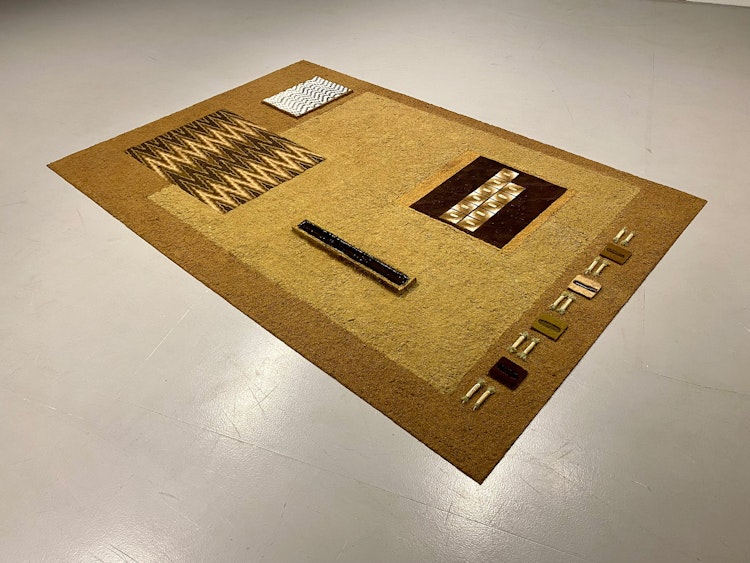
Engaging with material through craft is a way to simultaneously be active and passive. Somewhat like an alternating current that constantly switches, oscillates, or zigzags between two states. An alternating vibration that stimulates and connects realities. The “active” is knowledge that over time becomes more and more engrained into the hands as tacit knowledge. It becomes instinctive and intuitive. It is what people talk about as the meditative aspect of a repetitive skilled action. This is an active approach, but the more engrained the skills become, the more it opens up for a simultaneous passive aspect to it. It is therefore necessary to practice passivity to be prepared for the states that come up when practicing a skilled craft. Here the mind is allowed space, which is where the intuitive becomes available. Knowledge of the material is also a necessary aspect for these conditions to arise.
A consistent meditative practice has, for me, created space in practising craft and in engaging with the non-human world. Just as Deborah Head prepared me to dig for spruce roots in Alaska, a daily meditative practice allows me to cultivate a mindful state of being. It grounds me in the body through attention to the breath, awareness of sensations in the body, awareness of the senses and the different ways it allows me to absorb and become with the world that surrounds me.
Philosopher Gilles Deleuze has become another cornerstone in allowing me to understand and develop my practice. It might be that my Western mind finds it easier to grasp some of the ideas of Buddhism through Deleuze’s concepts. His ideas of difference and becoming describe emptiness and impermanence quite beautifully.6 He proposes difference not as a function of a stable identity; he proposes that difference in itself is all-encompassing, and not based on some other thing. In the nature of this difference is a constant movement, not a static being, but a becoming.7
Not a linear becoming, but a chaotic becoming where all processes are interacting differently according to what they are interacting with. In much the same way Buddhism describes the world as aggregates, or heaps, of interacting processes, humans as well are just heaps of interactions in a state of constant change.
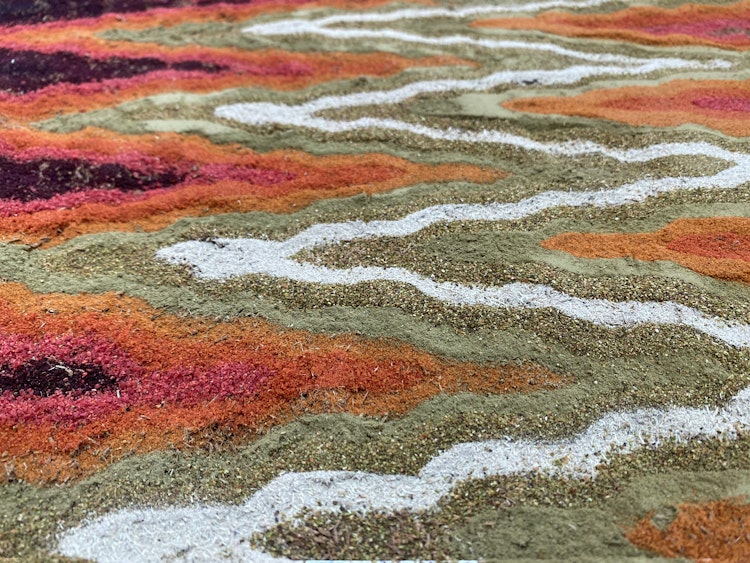
Deleuze emphasised the lack of a point of origin in these interactions. He introduced the concept of simulacra to differentiate his point from that of phenomenology, where a phenomenon is an appearance of some world.8 Deleuze removes the world from the equation entirely and we are left with appearances. Our becoming is, along with appearances, just as much a part of this flow. We are not nodes in the flow, we are the flow.
I try to embrace this way of becoming as a part of a more-than-human world. I become the process and the materials I interact with, and the processing of the materials and following assemblages resulting from these interactions are new becomings, that are influenced by interactions with traditions and histories. The momentary assemblages are, like us, as Deleuze would say, relatively stable moments in a flow of becoming-life. The relative stability of these moments are attempts at emphasising the flow of difference that they are a part of. The assemblages are deconstructed and re-enter the flow and reappear in future works in a different form.
Manifesting in Time
In The Spell of the Sensuous (1997) by philosopher David Abram, he explores how perception and language weave us into the web of the more-than-human world.9 He explores ideas of how the fabric of time and space are seen by people with strong oral traditions in aboriginal Australia and indigenous peoples in North America. In discussing the Hopi of North America, he relates linguist Benjamin Lee Whorf’s study revealing that the Hopi have no separate notion of time.10
Time is instead a factor of space. They do however, according to Whorf, have two different modalities of living; he named these modalities manifested
and manifesting. Manifested comprises anything available to the senses, that includes everything in our past and present. Manifesting however, refers to that which has yet to be, but also everything we would understand as part of the mind; or as the Hopi would say, of the heart; not only of humans, but also of plants, animals, things, and nature as an entity itself.11 I think Deleuze would refer to this mental space as the area of imagination. Our power of memory put into action to access the manifesting.
Fortunately, at least according to David Abram, we are created for this exact purpose:
Our bodies have formed themselves in delicate reciprocity with the manifold textures, sounds, and shapes of an animate earth — our eyes have evolved in subtle interaction with other eyes, as our ears are attuned by their very structure to the howling of wolves and the honking of geese. To shut ourselves off from these other voices, to continue by our lifestyles to condemn these other sensibilities to the oblivion of extinction, is to rob our own senses of their integrity, and to rob our minds of their coherence. We are human only in contact, and conviviality, with what is not human.12
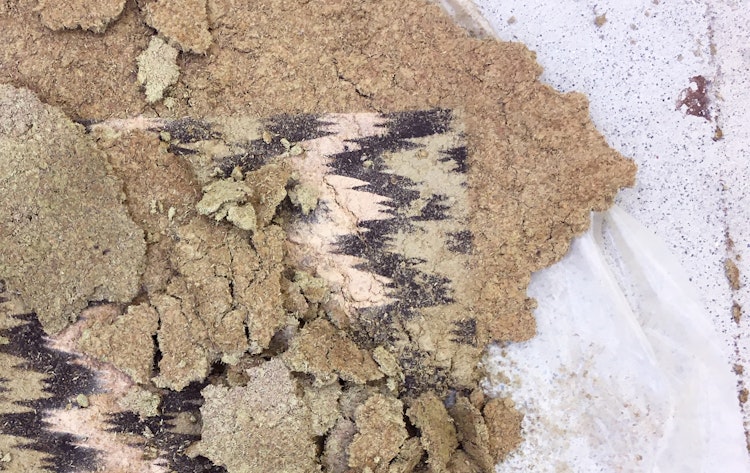
Therein lies the beautiful paradox of trying to be more in touch with, or become, an inseparable part of the non-human; you must become more human. The Buddha asks us to live in the moment through the awareness of the in and out breath. In this moment there is no need for metaphysical speculation. There is no longer human and non-human, only becoming together.
In creating these ephemeral heaps where materials are chopped and ground into a mush, they embody my attempt to disappear into the world by engaging intensely with it. I pile ground spruce needles and all kinds of ground plant material (some of which have already been ground up and processed through the body of an animal), along with pulverised antlers, mushroom spores, and woven and bound objects made from roots and plant fibers. I put them together in a system so they can all be seen, if only for a moment, before they blend together again, hopefully letting me come along.